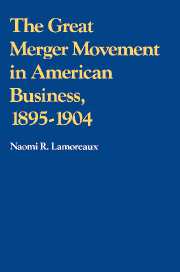Book contents
- Frontmatter
- Contents
- Acknowledgments
- List of tables and figures
- 1 Introduction
- 2 Product differentiation, mass production, and the urge to merge: competitive strategies and collusion in the late nineteenth century
- 3 High fixed costs and rapid expansion: a model of price warfare and two examples
- 4 Quantitative and qualitative evidence on the great merger movement
- 5 What changed? The impact of consolidations on competitive behavior
- 6 The great merger movement and antitrust policy
- 7 Conclusion
- Bibliographical essay
- Index
7 - Conclusion
Published online by Cambridge University Press: 01 April 2010
- Frontmatter
- Contents
- Acknowledgments
- List of tables and figures
- 1 Introduction
- 2 Product differentiation, mass production, and the urge to merge: competitive strategies and collusion in the late nineteenth century
- 3 High fixed costs and rapid expansion: a model of price warfare and two examples
- 4 Quantitative and qualitative evidence on the great merger movement
- 5 What changed? The impact of consolidations on competitive behavior
- 6 The great merger movement and antitrust policy
- 7 Conclusion
- Bibliographical essay
- Index
Summary
In The Visible Hand, Alfred D. Chandler, Jr., argued that the most significant development in the history of the American economy (and indeed the world economy) was the emergence of large, vertically integrated, multiplant enterprises in which, improving on the operation of Adam Smith's invisible hand, professional managers coordinated the flow of product from raw-material sources to finished markets. According to Chandler, some of these large multiplant enterprises developed through a process of internal growth, following out the logic of innovations by key entrepreneurs such as Gustavus Swift or Isaac Merritt Singer and Edward Clark. More frequently, however, they had their beginnings in the very different process of horizontal combination. Formed to escape the severe price competition of the late nineteenth century, many of today's largest industrials originated as consolidations. They survived and prospered, Chandler argued, because their officers then followed the example of companies like Swift and Singer, integrating backward into raw materials and forward into marketing.
Chandler concentrated, for the most part, on the first of these two processes. The second, and in particular the great merger movement, received much less attention from him. My aim in this study has been to fill this gap–to understand why so many firms suddenly merged into horizontal combinations, what the effects of these mergers on competitive behavior were, whether or not the visible hand of the manager was in fact an improvement over the operation of the market.
Consolidations, I have concluded, were by no means an inevitable component of the rise of modern industry, even though so many important firms had their origins in these mergers.
- Type
- Chapter
- Information
- The Great Merger Movement in American Business, 1895–1904 , pp. 187 - 194Publisher: Cambridge University PressPrint publication year: 1985



